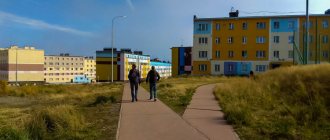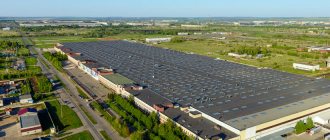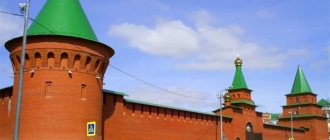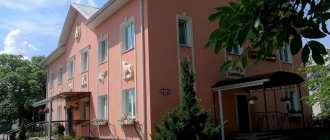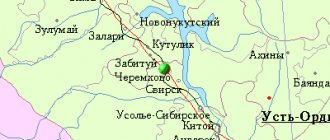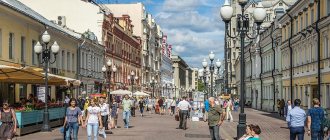Time moves at a breakneck pace. It dictates rules and foundations to us. Sometimes we don’t notice how the best years of our lives fly by. But as soon as you stumble upon an old photograph, the locomotive of life, rushing into the future, slows down and makes a stop at a station called Nostalgia. Agree, it’s nice to remember the past and admire places dear to your heart and soul. And for those who are still young, hear a story about the life of their ancestors. Today we will meet the “keeper of Gomel time,” photographer Alexander Vesnin, who collects old photographs of the city and Gomel residents.
I was looking for Sovetsk - I found Gomel
Alexander has been interested in photography all his life. He is interested in her not only as a photographer, but also as the creator of an online gallery on the history of Gomel. It all started with the fact that he was looking for photographs of Sovetsk, where he graduated from film college. It was difficult to find photos. And Alexander thought that there are people who have the same difficulties finding old photographs of Gomel.
“I haven’t come up with anything more interesting than collecting photographs,” Vesnin explained.
Gomel. 1987 Photo from the archive of Igor Shtermer
Historical reference
Sovetsk is a city in the Kaliningrad region of the Russian Federation, the former German Tilsit, in which the famous Peace of Tilsit was concluded.
Initially, Alexander only posted his own pictures. Later the collection was replenished with photographs created by other people. The gallery focuses on old images. When there were a lot of pictures, the author organized the photos into sections and tried to label them. Viewers and acquaintances regularly help with this.
For Alexander, photography is of historical value.
“Today time flies so quickly,” says Vesnin, “that changes in the appearance of the city are visible in 3-5 years, and what can we say about the city 20-30 years ago. People miss old green Gomel and look at photographs.
Because of nostalgia, people are interested in the photographer's albums. They discuss the pictures and share their impressions. Dialogues last for years and even lead to quarrels. The geography of connoisseurs of old photography is growing every year. For Gomel residents who have left to live in other places, this is an opportunity to get in touch with their youth. Sometimes, at the request of friends who have moved, the photographer takes photographs of specific places in the city. People appreciate it.
The intersection of Sovetskaya and Rogachevskaya streets. 1968 Photo by Vasily Klimov
How Gomel has changed: the city in old and modern photos
The most significant changes in the appearance of Gomel occurred after the Great Patriotic War, when the city had to be rebuilt almost from scratch. However, if you look at photographs taken 50-70 years ago, you can see other differences. Vacant lots have turned into microdistricts, old buildings have been modernized. Some views evoke nostalgia for lost landscaping, while others make it clear that over a short period of time, changes even affect architecture. Our correspondents looked for differences by turning to old photos from the collections of Gomel residents Alexander Vesnin and Andrey Karneev.
SOVETSKAYA STREET
The photo of Sovetskaya Street attracts attention with the abundance of greenery. It was made in 1962. There are thick chestnut trees along the roadway and a green hedge with a decorative fence.
Today, instead of asphalt there are tiles with elements of Belarusian ornaments. The lawn and hedge disappeared, and all that was left of all the green splendor were small robins and thujas in pots. But the buildings are perfectly visible, each of which is worth admiring.
LENIN AVENUE
And this is already approximately 1960-1961. View of Lenin Avenue towards the station. The landmark - the building of the Gomel Road Construction College - is almost ready, but is still surrounded by a fence. It was put into operation in 1961. Of course, the left wing could have been completed later, but there is also no trolleybus contact network, and in 1962 the “unit” was already running. On the left we see the production building of the Comintern. It has already been demolished, and in its place the Giprozhivmash Institute rises.
TSARIKOVA STREET
In the late 70s, at the beginning of Tsarikov Street, the first nine-story panel houses in the Selmashevsky microdistrict were built. And the street itself was reformatted from a road for horse-drawn carts into a wide avenue with bus traffic. It is noticeable that in this case there was incomparably more greenery than in the year the construction of the high-rise building was completed.
CENTRAL SQUARE
The building of the Gomel branch of RUE Beltelecom was still under construction in 1978 and was a concrete skeleton without finishing with glass panels. In 2022, it was decided to modernize it. External walls and decorative pylons were lined with porcelain stoneware slabs and metal façade cassettes, and stained glass windows were replaced. A giant flagpole will go up in front of the building this year.
PROLETARSKAYA STREET
The children's cinema named after Isachenko was located to the right of the entrance to the central park. In the 1970s, there was an indoor dance floor “Chudilovka” and a shooting range nearby. The photo clearly also belongs to this period. As collector Alexander Vesnin recalls, in the fall of 1970 the film “Waterloo” was released worldwide, the poster of which is visible in the picture. Now, on the site of the cinema, the building of the regional Palace of Children and Youth Creativity has been built.
PUSHKIN STREET
Looking at the photo of the Palace of Culture of Local Industry and Consumer Services, Gomel residents remember their trips to dances. The palace had its own vocal and instrumental ensemble, which performed foreign pop songs, which was in great demand. Since the spring of 2004, the building has housed the Puppet Theater. And it is loved by its visitors no less than in Soviet times. There were fewer trees in this case as well, and the flower beds at the entrance were completely covered with paving slabs.
KIROVA STREET
Pedagogical Institute named after V. Chkalov, 1950. Judging by the attributes, elections to the Supreme Soviet of the USSR are taking place. Today, in the educational building No. 2 of the Gomel State University named after F. Skorina, a polling station is also permanently located. But we are not interested in politics, but in architecture. It is noticeable that this building has undergone repairs more than once. Did it ruin him? Needless to say, the central façade looks great. But it’s still a pity for the observation tower on the roof.
FRUNZE STREET
In 1961, freight trains arrived in Gomel using locomotive traction. In general, everything at this place has changed over almost 60 years, even down to the configuration of the slopes of the excavation. The forge overpass has long lost its transport function. After a partial collapse, it is used only by pedestrians from the Monastery. And the power plant in the background went through another reconstruction a couple of years ago and today is a modern energy facility. All that remains is to compare and be amazed at the speed of progress.
belkagomel.by. Photo: Maria Amelina
Reproduction of this material without the permission of the editor is prohibited
Goodbye Africa, where I've never been
Alexander loves Gomel with all his heart. Lives here since 1969. His parents were bridge builders and wandered around the Soviet Union. The family huddled in trailers and barracks in Lithuania, Latvia, and the Kaliningrad region, and received an apartment in Gomel. Alexander's father participated in the construction of many bridges in the Gomel region, including the pedestrian bridge across the Sozh. He instilled in Alexander a love for photography.
— My father was interested in photographic equipment. He even filmed while on a business trip to Guinea. Although due to the difficult international situation this was prohibited. In the city where he lived, you couldn’t appear with a camera, only in your villa or in the suburbs, where no one would see. I also wanted to visit Africa, but they didn’t take me. I was in the eighth grade, but they took me up to the fourth. In 1972, they called me for the holidays, but there was aggression. The capital of Guinea was attacked by a Portuguese squadron, and the parents spent three days sitting on suitcases in the toilets, while the city was shelled and bombed. The Cubans helped repel the Portuguese attack. The conflict was settled, but the trip was cancelled. And my parents have many interesting memories.
Alexander loves to photograph people at work, in everyday situations. He photographs events that are significant for the city, and takes pictures of streets that are rarely photographed.
May 2, 1963 Photo by Alexander Lemeshkov
Natural attractions
City Park named after. Lunacharsky is considered the pearl of the city . In the center of it there is the already well-known Rumyantsev-Paskevich Palace and the famous Peter and Paul Cathedral. But don’t forget that this is a very beautiful and cozy park.
This is where the picturesque Swan Lake pond is located. If you don’t know where to go in Gomel with a girl, our advice is to go to the Swan Pond. This is a very beautiful and romantic place.
In addition to the beauty of the lake, you will be delighted by 4 floating fountains and a beautiful water cascade. And what girl can resist sophisticated, loyal swans?
Another great place for a walk can be the River Embankment. Sozh.
Search
People give Alexander photographs, he receives some from Internet users, and buys others at auctions.
“It’s difficult to buy,” Vesnin admitted, “you constantly need to monitor it.” Collectors buy interesting cards. It happens that a photo appears in the morning, but by lunchtime the photo is gone. And the prices are steep. Cheap photos sell for 2 - 5 euros, prices for expensive ones start from 20 - 30 euros. I can't afford it.
He carefully digitizes the photos that Alexander received from people and returns them back to the owners; he keeps only digital copies for himself, which end up in albums.
The first monument to Lenin on the square was erected in the 20s
Architecture
Palace of the Rumyantsevs and Paskevichs , located on pl. Lenina, 4, is one of the symbols of the city. Built in 1794 by the architect I. Starov in the style of early classicism, it still amazes with its beauty and majesty.
In 1826, the new owner decided to slightly rebuild the castle. Under the leadership of the architect A. Izdkovsky, an amazing park was laid out here, and they also began to collect a collection of paintings, which is still in the palace today. Now the Palace is considered a national symbol of Belarus , and it is also a rich museum.
Nikolsky Monastery , located on the street. D. Bednogo, 4, is also one of the main attractions of the city. Today the monastery houses a library and a Sunday school. On the territory of the monastery there are also several especially revered Orthodox shrines. And the appearance of the monastery is very beautiful.
We also recommend visiting the Peter and Paul Cathedral . This is one of the oldest temples in the city, the construction of which took about 10 years. The temple is very beautiful and has amazing harmony.
In addition to the fact that many revered shrines are kept here, the cathedral is now the center of the spiritual life of the city, and there is also a school where clergy and deacons are trained. You will find the cathedral at pl. Lenina, 6.
Sights of Gomel and Gomel region:
Hunting Lodge (Pushkin St., 32);
Gomel Drama Theater (Lenin Square, 1).
Church of the Nativity of the Blessed Virgin Mary (Sovetskaya St., 118).
St. Tikhvin Monastery (Kotovskogo St., 38).
Observation tower (Gomel Park).
Ilyinskaya Old Believer Church (Kommissarova St., 44).
History in rolls
An invaluable contribution to Alexander’s collection was made by his new acquaintance, Mikhail Shumsky. He gave the photographer old films that had previously belonged to a person associated with the photo circle of the Palace of Pioneers. As Alexander said, the films were strung on a piece of wire in rolls. Some trimmings, defects, but among this there were also preserved frames. Having compared the facts, Alexander and Mikhail determined that the films were shot between the 55s and 60s. This was indicated by footage in the House of Pioneers, which was located from 1948 to 1955 in the 10th school, and photos with the schedule of sections and clubs over the years.
— It’s interesting to see how people dressed, their spiritual faces, the central beach on the other side of Sozh, or the square without the Lenin monument. The children learned to film themselves, but the background preserved the history of the city.
Near the fountain in Gomel park
Museums
Museum of the History of the City of Gomel , located in the “Hunting Lodge” at st. Pushkina, 32, is one of the important landmarks of the city.
The museum contains interesting exhibits telling about the Gomel region of different times. There are both permanent exhibitions and thematic exhibitions of local artists, sculptors and craftsmen. Meetings with writers, holidays and various master classes are also held here.
We also recommend visiting:
Art gallery of G. Kh. Vashchenko (Karpovich St., 4 and Lenin Ave., 43).
Museum of Forensic Science (Pushkin St., 1).
Museum of Theater Puppets (Pushkina St., 14).
Khrushchevs are young again
In the 1960s, in the Festival microdistrict, the Gomel DSK actively built inexpensive housing for citizens. By January 1965, the builders reached Volgogradskaya Street. In the photo you can see a house on the ground floor of which various healthcare institutions were located, and now an ophthalmology clinic.
Over the past years, all the houses in this area have undergone major renovations; they have become “young” again. Their color has changed. And since then there has been much more greenery.
State University on Sovetskaya
Sovetskaya Street had such an unaesthetic appearance in the early 1970s during the construction of the main building of Gomel State University and the dormitory next to it. The university building was put into operation in 1972. It still looks modern today and fits well into the overall architecture of this section of the street. We have a multi-lane road, and the approaches to the GGU are paved with tiles.
What to see in Gomel in 1 day
If you have a couple of free hours, then you shouldn’t refuse to explore this wonderful city. First of all, you need to see the main attractions of Gomel.
Ferris tower
The 40 m high structure has stood in Gomel since the 19th century. Initially it served as an exhaust pipe to remove smoke from the boiler room. Then it became part of a sugar factory owned by F. Paskevich.
Later, the owner refurbished the tower, making an observation deck at the top, and laid out a Winter Garden nearby. The building has become a recognizable symbol of the city of Gomel. The appearance of the tower has remained unchanged since its construction. In 2007, the staircases were reconstructed.
Address: park named after. Lunacharsky.
Opening hours (except Monday): Tue.-Fri. – 11.00-19.00, Sat.-Sun. – 10.00-18.00.
How to get there: bus. 4, 4A, 4T to st. Gagarin, walk 440 m.
Get directions
Zero kilometer
The Gomel landmark was cast by craftsmen. The 1 m high memorial sign was inaugurated ten years ago. It is a cube on a column-leg with a pyramidal top. On four sides there are emblems made of yellow metal, the 19 sister cities of Gomel and the distance to them are indicated.
Address: pl. Lenin.
How to get there: trolleybuses 1, 15, 16.
Get directions
Baumansky Bridge
Despite the many bridges in Gomel, until the 70s. You could only get from the park to the beach by boat. Water transport operated at large intervals and could not accommodate everyone, so the Gomel administration decided to build a bridge for pedestrians.
The building continues the street named after. Bauman, runs above Kievsky Descent. The height of the spans does not interfere with navigation. This is a favorite place for walking and filming, as from the bridge there is a stunning panorama of the Sozh, the embankment, and the city.
Address: pl. Lenina, 4.
How to get there: by trolleybuses 1, 16, go through the park to the river.
Get directions
Winter Garden
It appeared in the city thanks to Prince Paskevich, who ordered the premises of an inactive plant to be converted into a greenhouse. The inner side of the walls is lined with natural stone and serves as a support for climbing plants. There are 25 species of bushes and trees represented here. Many come from the subtropics: palm trees, lemon, laurel, magnolia.
Address: park named after. A. Lunacharsky.
Opening hours: in winter – 11.00-19.00, in summer – 10.00-18.00. Sanitary days: 1st, 3rd Monday of the month.
How to get there: by buses 5T, 21T, 21A, 35 to the measuring instruments plant, walk 930 m.
Get directions
Monument to the first settler of Gomel
The most popular part of the city embankment is near the sculpture of the hunter, who was the first to settle on the site of the future city. It is difficult not to notice, since the composition is large-scale and expressive. The sculptor captured the moment of arrival: on a pedestal in the form of waves there is a boat, in it there is a man in ancient attire, with a bow on his back and a lynx at his feet. The animal became a city symbol back in the 18th century, appearing on the coat of arms of Gomel.
The composition of the landmark was invented and implemented by sculptor Vyacheslav Dolgov. He is the author of other Gomel monuments: Organ Grinder, Running Passenger, Pencil.
Address: embankment.
How to get there: trolleybuses 1, 16 to Central Park, go to the embankment.
Get directions
Barykina Street and Communication House
The longest street in the city begins at house No. 1, the only multi-story building on this site. In the late 1950s it was paved with cobblestones and there was little traffic. The usual Kuznechny overpass did not exist yet either.
Now cars are flying down the street at high speed. The roadway was widened to six lanes. Soon the House of Communications will be lost against the backdrop of high-rise buildings, which are gradually replacing post-war manor-type houses here.
School on Zharkovsky and memorial stele
In the early sixties, the front yard of School No. 11 was surrounded by a brick fence, behind which there was a garden. According to the testimony of townspeople, already in November 1963, on the 20th anniversary of the liberation of Gomel, the garden was removed, and a stele was erected on the square in front of the school in memory of the underground Komsomol members who died during the war (official sources indicate the year 1964). In 1975, the stele was supplemented with a bronze figure of a Komsomol member.
The same eyewitnesses claim that Konstantin Rokossovsky personally came to the opening of the monument, and after the ceremony he met with honored Gomel residents.
Victory Street and St. George's Church
On September 21, 1961, the St. George Church was demolished, the building of which at that time housed the city physical education center. Athletes who trained in those years recall that it was well adapted for training, and republican competitions were held there. However, the building interfered with the implementation of the city planners’ plans to create a boulevard on Pobeda Street, since it occupied almost its entire width in the place where Pobeda Avenue now intersects with Sovetskaya. It’s a pity for the building, but the city’s guests are not ashamed of the current state of the territory.


